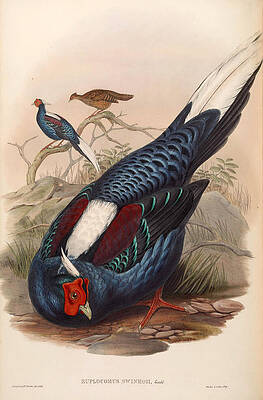Superregnum: Eukaryota
Regnum: Animalia
Subregnum: Eumetazoa
Cladus: Bilateria
Cladus: Nephrozoa
Superphylum: Deuterostomia
Phylum: Chordata
Cladus: Craniata
Subphylum: Vertebrata
Infraphylum: Gnathostomata
Superclassis: Tetrapoda
Cladus: Reptiliomorpha
Cladus: Amniota
Classis: Reptilia
Cladus: Eureptilia
Cladus: Romeriida
Subclassis: Diapsida
Cladus: Sauria
Infraclassis: Archosauromorpha
Cladus: Crurotarsi
Divisio: Archosauria
Subsectio: Ornithodira
Subtaxon: Dinosauromorpha
Cladus: Dinosauria
Ordo: Saurischia
Cladus: Theropoda
Cladus: Neotheropoda
Infraclassis: Aves
Cladus: Euavialae
Cladus: Avebrevicauda
Cladus: Pygostylia
Cladus: Ornithothoraces
Cladus: Euornithes
Cladus: Ornithuromorpha
Cladus: Ornithurae
Cladus: Carinatae
Parvclassis: Neornithes
Cohors: Neognathae
Cladus: Galloanseres
Ordo: Galliformes
Familia: Phasianidae
Subfamilia: Phasianinae
Genus: Lophura
Species: Lophura swinhoii
Name
Lophura swinhoii (Gould, 1863)
Synonymy
Euplocamus swinhoii (protonym)
Lophura swinhoii, Henry Constantine Richter
References
Proceedings of the Zoological Society of London 1862: 284.
Vernacular names
العربية: تدرج سوينهو
български: Седлат фазан
brezhoneg: Fazan Swinhoe
català: Faisà de Swinhoe
čeština: Bažant Swinhoeův
Cymraeg: Ffesant Swinhoe
Deutsch: Swinhoefasan
English: Swinhoe's Pheasant
Esperanto: Blua fazano
español: Faisán de Swinhoe
français: Faisan de Swinhoe
עברית: פסיון סווינו
magyar: Nyerges fácán
italiano: Fagiano di Swinhoe
日本語: サンケイ
한국어: 산계
македонски: Тајвански фазан
Nederlands: Swinhoes fazant
پنجابی: سونہو بن ککڑ
português: Faisão-de-swinhoe
русский: Свайнова лофура
svenska: Swinhoefasan
Tiếng Việt: Gà lôi lam lưng trắng
Bân-lâm-gú: Hôa-ke
中文: 蓝鹇
Swinhoe's pheasant (Lophura swinhoii), also known as the Taiwan blue pheasant, is a bird of the pheasant subfamily in the fowl family Phasianidae. It is endemic to Taiwan. Along with the Mikado pheasant and Taiwan blue magpie, two other Taiwan endemics, Swinhoe's pheasant is sometimes considered an unofficial national symbol for Taiwan, as it bears the colours of the national flag (red, white, and blue).
Etymology
The bird was named after British naturalist Robert Swinhoe, who first described the species in 1862. Locally, the species is known in Mandarin as lánfùxián (Chinese: 藍腹鷴; lit. 'blue-breasted kalij'), and in Taiwanese Hokkien as wa-koe (華雞; hôa-koe; 'flowered fowl'; also 畫雞).[2]
Description
The male Swinhoe's pheasant can grow up to 79 cm. He has a glossy blue-purple chest, belly, and rump, white nape, red wattles, white tail feathers, and a white crest. The female is brown marked with yellow, arrow-shaped spots and complex barring patterns, and has maroon outer rectrices. The juvenile male is dark blue with brown and yellow patterns on its wings. Swinhoe's pheasants can also be distinguished from the Mikado pheasant by having red legs.
Male Swinhoe's pheasant with wattles fully engorged for display
Juvenile Swinhoe's pheasant
Female Swinhoe's pheasant
During display, the male's wattles become engorged and he performs a display consisting of a hop followed by running in a circle around females. A frontal display with the tail fanned is occasionally observed. He also does a wing-whirring display like other Lophura pheasants.
Egg - MHNT
Habitat
Swinhoe's pheasant is found in the mountains of central Taiwan, where it lives in primary broadleaf forest up to 2,300 m in elevation.[1]
Behaviour
Swinhoe's pheasant eats seeds, fruits, and some insects and other animal matter. Predators include the crested goshawk, white-bellied sea eagle, Gurney's eagle, spot-bellied eagle-owl, and the civet and badger.
The female lays a clutch of two to six eggs, which are incubated for 25 to 28 days. The young can leave the nest at 2-3 days old. Swinhoe's pheasant is often assumed to be polygynous, as males are often seen with several females, though confirmation is lacking.
Conservation
This pheasant has a small population in a limited range that is shrinking due to habitat degradation. Logging is a problem. It was hunted in the past, and some populations were extirpated in the 1960s and 1970s. Today, its global population is estimated to be over 10,000 individuals.[1] Some populations are secure within protected areas, but others may be declining. Alongside the Mikado pheasant and Taiwan magpie, they are sometimes unofficially considered national symbols of Taiwan, which has helped in their conservation and protection. In some areas, such as Dasyueshan National Forest Recreation Area, they are regularly sighted feeding along roadsides, which have become bird-watching hotspots. Often they are fed by bird photographers, which has considered a controversial practice by some conservationists and liable to a fine by park officials.
See also
List of protected species in Taiwan
References
BirdLife International (2012). "Lophura swinhoii". IUCN Red List of Threatened Species. 2012. Retrieved 26 November 2013.
Iûⁿ, Ún-giân (2006). "Tai-gi Hôa-gí Sòaⁿ-téng Sû-tián" 台文/華文線頂辭典 [On-line Taiwanese/Mandarin Dictionary] (in Chinese and Min Nan Chinese).
Retrieved from "http://en.wikipedia.org/"
All text is available under the terms of the GNU Free Documentation License


